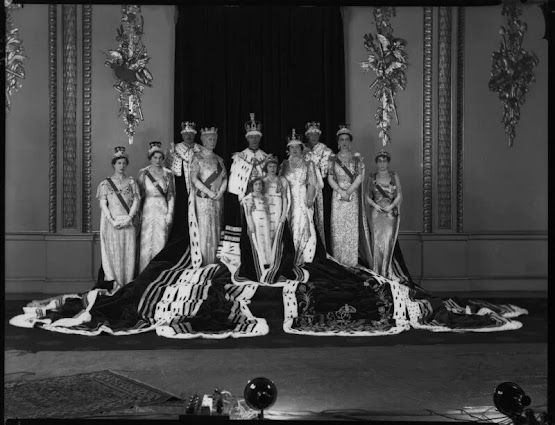Caparison (pronounced kuh-par-uh-suhn)
(1) A decorative covering for a horse or for the tack or
harness of a horse or other animal; trappings (historically applied especially
to warhorses).
(2) Rich and sumptuous clothing, ornaments or equipment.
(3) To cover with a caparison (usually in ceremonial
military use).
(4) Richly to dress; to deck out.
1585–1595: From the Middle French caparasson (“cloth spread over a saddle” and “personal dress and
ornaments”) (which survives in Modern French as caparaçon), from the Old Spanish caparazón (saddlecloth (and akin to capacape)) which may have been from the Old Occitan capairon or perhaps from the augmentative
of the Old Provençal caparasso (a
mantle with a hood), or the Medieval Latin caparo
(a type of cape worn by women (literally "chaperon")). Caparisoned (the past-participle adjective
developed from the verb) dates from circa 1600 and was from the French caparaçonner, from caparaçon. Even among those
who contest the etymology, none appear to deny a link with cape which was from
the Middle French cap, from the Occitan
cap, from the Latin caput (head). A doublet of caput, chef and chief (and more distantly
of head), as used to describe a "sleeveless cloak, circular covering for
the shoulders" which came in the sixteenth century to be regarded as “the Spanish
style, it was from the French cape,
from the Spanish capa, from the Late Latin cappa (hooded cloak). In the Late Old English there was capa & cæppe
(cloak with a hood) which came directly from the Latin. Caparison is a noun & verb, caparisoning
is a verb, caparisoned is an adjective and although it’s non-standard,
caparisonistic would seem useful; the noun plural is caparisons.
Depiction of caparisoned horses in Medieval jousting tournament (left), an example of the use of metal armor with plate croupiere, criniere, and peytral, Kunsthistorisches Museum, Vienna, Austria (centre) and a caparisoned goat (a military mascot) at the proclamation of Charles III (b 1948; King of the United Kingdom since 2022) (right). In modern equestrian management, the functional caparison remains an essential item of equipment and what are usually called horsecloths or horse rugs are sold in a variety of weights (tied to the seasons, the winter versions being heavier than those intended for use in the spring or fall (autumn)) and, depending on need, can be waterproof. They’re helpful too as protection from wind and even biting insects.
Caparisons are now usually decorative and in military use are often decorated with regimental standards or other unit markings. Their origin however was purely functional and dates from Antiquity as coverings for horses (and, east of Suez, elephants too) to afford the beasts come protection for arrows, bladed weapons etc. Of course, any sort of layered protection adds weight so whether it’s a truck, a warship or a horse, there are trade-offs, the addition of the protection meaning there’s a reduction in speed, carrying capacity or other measures of performance so the designs varied according to intended purpose, an animal intended for use in knee-to-knee charges fitted with a lighter caparison. Metal and heavy leather caparisons were not unknown but were quite a burden so most were crafted from a variety of fabrics. Surprisingly, the material used could be remarkably effective and while not able always to resist penetration, often deflected arrows and blows from swords and lances of delivered at less than an optional angle or very short-range.
Caparisoned: Royal group photograph (from an originally un-published negative used to control for light and angles), one of a session taken to mark the coronation of George VI (1895-1952; King of the UK 1936-1952).
By extension, caparison as both a noun & verb can be used of the rich, sumptuous or elaborately embellished clothing or regalia worn by people or draped over objects. For the modern coronation ceremonies concocted by the British monarchy (which owe more to Hollywood than actual British tradition), it had become the practice to dress the family in the full panoply of regalia and this is something Charles III apparently indicated he’d like to tone down but his coronation seemed to indicate the views of the courtiers (who enjoy dressing-up like the Spice Girls) and the palace’s media operation (which understands the appeal of spectacle) prevailed. The generals in the army also relish a good parade. Appalled at the inter-war suggestion the mechanisation of the army would mean horses would no longer be required, the British politician Duff Cooper (1890-1954) borrowed from a 1926 article by Field Marshal Douglas Haig (Earl Haig, 1861–1928; commander-in-chief of British Army forces on the Western Front 1915-1918), writing approvingly: "There will always be a place in the British Army for a well-bred horse". Cooper's biography of Haig (in two volumes, 1935-1936) had been commissioned by the executors of the field marshal's estate and although not entirely hagiographic, was certainly generous. Attending the coronation of Kind Charles were many caparisoned people, horses and goats, mostly well-bred.



No comments:
Post a Comment